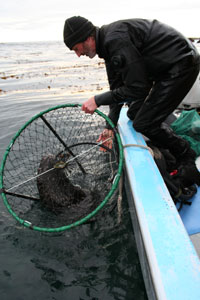 A sea otter in Wilson trap being brought aboard the boat.
A sea otter in Wilson trap being brought aboard the boat.
Sea otters are regularly captured in the wild for ecological studies conducted jointly by the USGS, CDFW, and Monterey Bay Aquarium. For more on these studies, see the USGS Pacific Nearshore Project page. Sea otters may also be captured in the wild in the event of an oil spill.
There are three methods by which we capture sea otters: dip net, tangle net and Wilson trap. The method of choice will depend of the location and activity of the otter and the level of expertise of the personnel.
- Dip netting requires the least amount of specialized equipment: fast, maneuverable boat; stout, long-handled dip net; an experienced boat driver and a strong person to handle the dip net. This method is best suited for capture of otters hauled out or young otters in open (no kelp) water. For water captures, the boat approaches the otter at high speed and then the driver throttles-back as a person on the bow scoops the otter into the net. Often, if the otter evades the first capture attempt, it will be very difficult to capture on subsequent attempts.
- Tangle nets are modified gill nets approximately 3-9m deep and 33-100m long that are set at the water surface in areas of open water or in channel within the kelp. The nets are set to entangle otters as they travel/swim into the net. A large number of otters may be captured, but this method is the least selective capture technique. To avoid injury to the captured otters, the nets must be continuously monitored and entangled otters removed quickly. Caution must also be taken to avoid incidental capture of other marine mammals in the area.
- Diver operated Wilson trap is a method that is very effective for the capture of specifically selected otters. Experienced teams can often capture more than one otter at a time. Over the years there have been numerous equipment alterations or “upgrades” however the general technique has remained the same. The trap consists of a cone-shaped, aluminum frame which supports a net bag. The trap is attached to a diver propulsion vehicle (DPV). Divers using rebreathers (closed-circuit SCUBA that produces no bubbles) can operate the DPVs with traps to approach targeted otters from underwater without producing bubbles that would alert and spook the otters. Once divers maneuver their DPVs and traps into position under the targeted otter(s), the DPV is driven straight up at full speed to trap the otter(s) at the surface. A purse-string is used to close the net bag when the otter is in the trap. See a video of the underwater capture technique.